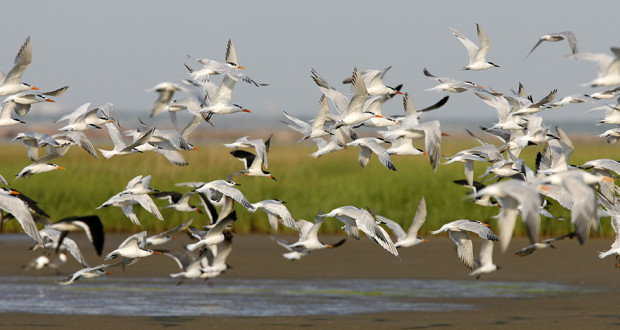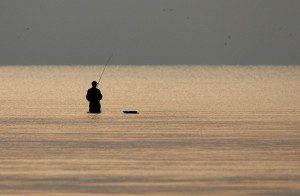The Flats trace their origin to a 5-mile-long jetty at the mouth of Galveston Bay, built in 1898 by the U.S. Corps of Engineers to protect shipping. The jetty interrupts the flow of sediment along the coast. As the current slows, it drops its silt and sediment, building up nearby beaches and wetlands and creating the Bolivar Flats estuary.
After turning onto the beach from Retillion Road, you’ll turn right and drive until the way is blocked by cable and pilings. Parking usually is not a problem if you get there early. You’ll only have to contend with a few overnight campers and fisherman. On calmer days, when the bay is almost glass, you’ll see the silhouettes of wade fisherman in the water as the sun rises.
The beach unravels for a stretch before fading as it turns around a point across the water from the dike. These mudflats, more exposed during low tide, are where many of the shorebirds feed. It’s not unusual to see tankers and container ships off in the distance in the bay.
If you walk slowly along the beach, the shorebirds will walk just a little bit faster to stay ahead of you. Though, if you stop and wait, they’ll sometimes walk toward you, too concentrated on scanning the rippling water for breakfast to notice.
On a good day during the fall and spring migrations, Bolivar Flats has among the most diverse collections of birds in the area – Brown Pelicans, American Oystercatchers, Black Skimmers, Whimbrels, Willets and sundry other shorebirds. Many birds nest in the dunes and marshes behind, so it’s best to keep to the beach.
In the spring, most migrating shorebirds pass through Bolivar Flats in April and the first two weeks of May, Cin-Ty Lee of Rice University explains in her 2007 essay, A Birdwalk on Bolivar Flats:
If you came to Bolivar in April, you would see breeding plumaged Western and Semipalmated Sandpipers, Sanderlings, Dunlins and Dowitchers in the thousands…. Because the shorebirds are constantly on the move, every day can be different. We do not know exactly how many shorebirds pass through Bolivar each spring, but the numbers are probably in the several tens of thousands. Spring migration is largely over by Memorial Day weekend, although a few stragglers are still passing through.
SANCTUARY GALLERY








You must be logged in to post a comment.